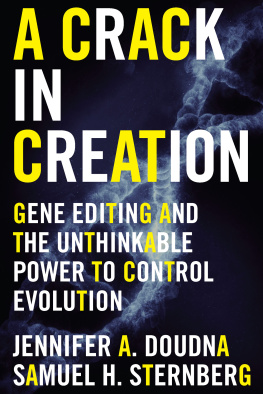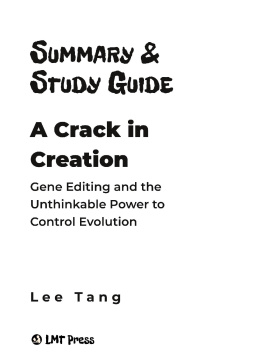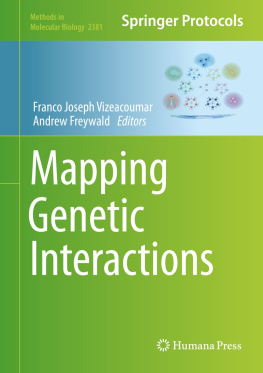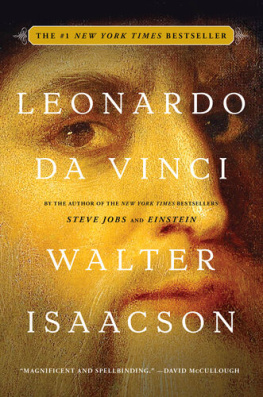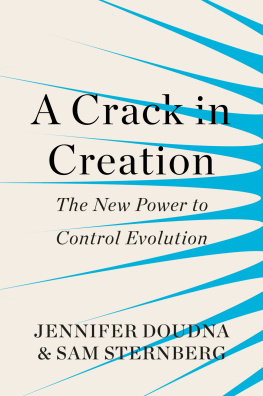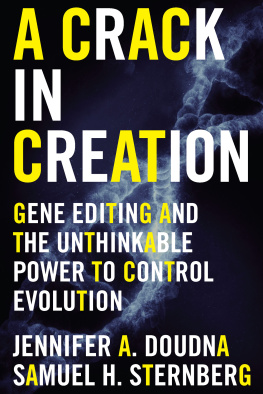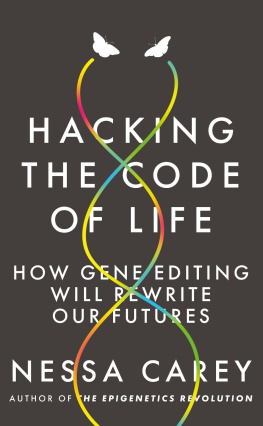Copyright 2017 by Jennifer A. Doudna and Samuel H. Sternberg
All rights reserved
For information about permission to reproduce selections from this book, write to or to Permissions, Houghton Mifflin Harcourt Publishing Company, 3 Park Avenue, 19th Floor, New York, New York 10016.
www.hmhco.com
Library of Congress Cataloging-in-Publication Data
Names: Doudna, Jennifer A., author. | Sternberg, Samuel H., author.
Title: A crack in creation: gene editing and the unthinkable power to control evolution / Jennifer A. Doudna, Samuel H. Sternberg.
Description: Boston: Houghton Mifflin Harcourt, 2017. | Includes bibliographical references and index.
Identifiers: LCCN 2016058472 (print) | LCCN 2016059585 (ebook) | ISBN 9780544716940 (hardcover) | ISBN 9780544716964 (ebook)
Subjects: | MESH: Gene Editinghistory | CRISPR-Cas Systems | Genetic Code | Genetic Researchhistory | United States
Classification: LCC QH440 (print) | LCC QH440 (ebook) | NLM QU 11 AA1 | DDC
576.5072dc23
LC record available at https://lccn.loc.gov/2016058472
Illustrations throughout the book drawn by Jeffery Mathison
Cover design by Martha Kennedy
Cover photograph kirstypargeter/Getty Images
v1.0517
To our parents, Dorothy and Martin Doudna (J.A.D.)
and Susanne Nimmrichter and Robert Sternberg (S.H.S.)
Science does not know its debt to imagination.
Ralph Waldo Emerson
Prologue:
The Wave
IN MY DREAM, I am standing on a beach.
To either side of me, a long, salt-and-pepper strip of sand runs along the water, outlining a large bay. It is, I realize, the shore of the island of Hawaii where I grew up: the edge of Hilo Bay, where I once spent weekends with friends watching canoe races and searching for shells and the glass balls that sometimes washed ashore from Japanese fishing boats.
But today there are no friends, canoes, or fishing boats in sight. The beach is empty, the sand and water unnaturally still. Beyond the breakwater, light plays gently along the surface of the ocean, as if to soothe the fear Ive carried since girlhoodthe dread that haunts every Hiloan, no matter how young. My generation grew up without experiencing a tsunami, but we have all seen the photos. We know our town sits in the inundation zone.
As if on cue, I see it in the distance. A wave.
It is tiny at first but grows by the second, rising before me in a towering wall, its crest of whitecaps obscuring the sky. Behind it are other waves, all rolling toward the shore.
I am paralyzed with fearbut as the tsunami looms closer, my terror gives way to determination. I notice a small wooden shack behind me. It is my friend Puas place, with a pile of surfboards scattered out front. I grab one and splash into the water, paddle out into the bay, round the breakwater, and head directly into the oncoming waves. Before the first one overtakes me, Im able to duck through it, and when I emerge on the other side, I surf down the second. As I do, I soak in the view. The sight is amazingtheres Mauna Kea and, beyond it, Mauna Loa, rising protectively above the bay and reaching toward the sky.
I blink awake in my Berkeley, California, bedroom, thousands of miles away from my childhood home.
It is July 2015, and I am in the middle of the most exciting, overwhelming year of my life. Ive begun having dreams like this regularly, and the recognition of their deeper meaning comes easily now. The beach is a mirage, but the waves, and the tangle of emotions they inspirefear, hope, and aweare only too real.
My name is Jennifer Doudna. I am a biochemist, and I have spent the majority of my career in a laboratory, conducting research on topics that most people outside of my field have never heard of. In the past half decade, however, I have become involved in a groundbreaking area of the life sciences, a subject whose progress cannot be contained by the four walls of any academic research center. My colleagues and I have been swept up by an irresistible force not unlike the tsunami in my dreamexcept this tidal wave is one that I helped trigger.
By the summer of 2015, the biotechnology that Id helped establish only a few years before was growing at a pace that I could not have imagined. And its implications were seismicnot just for the life sciences, but for all life on earth.
This book is its story, and mine. It is also yours. Because it wont be long before the repercussions from this technology reach your doorstep too.
Humans have been reshaping the physical world for millennia, but the effects have never been as dramatic as they are today. Industrialization has caused climate change that threatens ecosystems around the globe, and this and other human activities have precipitated a surge in species extinction that is ravaging the diverse populations of creatures with which we share this earth. These transformations have prompted geologists to propose that we rename this era the Anthropocenethe human epoch.
The biological world is also undergoing profound, human-induced changes. For billions of years, life progressed according to Darwins theory of evolution: organisms developed through a series of random genetic variations, some of which conferred advantages in survival, competition, and reproduction. Up to now, our species too has been shaped by this process; indeed, until recently we were largely at its mercy. When agriculture emerged ten thousand years ago, humans began biasing evolution through the selective breeding of plants and animals, but the starting materialthe random DNA mutations constituting the available genetic variationswas still generated spontaneously and randomly. As a result, our species efforts to transform nature were halting and met with limited success.
Today, things could not be more different. Scientists have succeeded in bringing this primordial process fully under human control. Using powerful biotechnology tools to tinker with DNA inside living cells, scientists can now manipulate and rationally modify the genetic code that defines every species on the planet, including our own. And with the newest and arguably most effective genetic engineering tool, CRISPR-Cas9 (CRISPR for short), the genomean organisms entire DNA content, including all its geneshas become almost as editable as a simple piece of text.
As long as the genetic code for a particular trait is known, scientists can use CRISPR to insert, edit, or delete the associated gene in virtually any living plants or animals genome. This process is far simpler and more effective than any other gene-manipulation technology in existence. Practically overnight, we have found ourselves on the cusp of a new age in genetic engineering and biological masterya revolutionary era in which the possibilities are limited only by our collective imagination.
The animal kingdom has been the first and, so far, the biggest proving ground for this new gene-editing tool. For example, scientists have harnessed CRISPR to generate a genetically enhanced version of the beagle, creating dogs with Schwarzenegger-like supermuscular physiques by making single-letter DNA changes to a gene that controls muscle formation. In another case, by inactivating a gene in the pig genome that responds to growth hormone, researchers have created micropigs, swine no bigger than large cats, which can be sold as pets. Scientists have done something similar with Shannbei goats, editing the animals genome with CRISPR so that they grow both more muscle (thus yielding more meat) and longer hair (meaning more cashmere fibers). Geneticists are even using CRISPR to transform Asian elephant DNA into something that looks more and more like woolly mammoth DNA, with the hope of someday resurrecting this extinct beast.
Meanwhile, in the plant world, CRISPR has been widely deployed to edit crop genomes, paving the way for agricultural advances that could dramatically improve peoples diets and shore up the worlds food security. Gene-editing experiments have produced disease-resistant rice, tomatoes that ripen more slowly, soybeans with healthier polyunsaturated fat content, and potatoes with lower levels of a potent neurotoxin. Food scientists are achieving these improvements not with transgenic techniquesthe splicing of one species DNA into a different species genomebut by fine-tuned genetic upgrades involving changes to just a few letters of the organisms own DNA.
Next page
